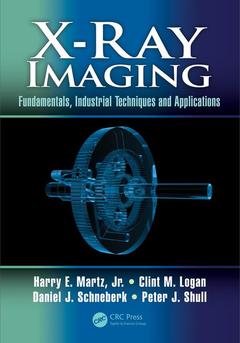X-Ray Imaging Fundamentals, Industrial Techniques and Applications
Auteurs : Martz Harry E., Logan Clint M., Schneberk Daniel J., Shull Peter J.

While books on the medical applications of x-ray imaging exist, there is not one currently available that focuses on industrial applications. Full of color images that show clear spectrometry and rich with applications, X-Ray Imaging fills the need for a comprehensive work on modern industrial x-ray imaging. It reviews the fundamental science of x-ray imaging and addresses equipment and system configuration. Useful to a broad range of radiation imaging practitioners, the book looks at the rapid development and deployment of digital x-ray imaging system.
NDE introduction. X-ray history. Radiography’s role. Photon fundamentals. Non-photon radiation imaging. Radiation transport modeling. Radiation dosimetry, safety, and shielding. Radiation sources. Radiation detectors. Imaging dimensionality. Scatter, collimators, motion control, and computers. Digital radiography and computed tomography. Image quality. Special techniques. Selected applications. Glossary. Variables. References.
Harry E. Martz is the director of the Nondestructive Characterization Institute and a distinguished member of the technical staff at the Lawrence Livermore National Laboratory. He is also principal investigator for the Department of Homeland Security, Science and Technology, Explosives Division; the Domestic Nuclear Detection Office, Nuclear and Radiological Imaging Platform; and Passive and x-ray Imaging Scanning Projects. He has also served on several National Academy of Sciences committees on aviation security and was the chair of the Committee on Airport Passenger Screening: Backscatter x-ray Machines. He is a member of the Physics Honor Society Sigma Pi Sigma.
Clinton M. Logan began his career at the Lawrence Livermore National Laboratory in 1963 after receiving his BSME degree from Montana State University. In 1993, Clint won a US Department of Energy (DOE) grant to apply Lawrence Livermore National Laboratory (LLNL) resources to support Fischer Imaging Corporation in the design of their full-field digital mammography unit for cancer screening. Clint holds five US patents in accelerator and x-ray technology. He is a registered professional engineer in California, a member emeritus of the American Association of Physicists in Medicine, and a fellow of the American Society of Mechanical Engineers.
Daniel J. Schneberk received undergraduate degrees (one of them in mathematics) from the University of Oregon and a master’s in statistics from the University of California, Berkeley (UC Berkeley). In 1988, Dan took an opportunity to join the nondestructive evaluation group at LLNL, collaborating with Harry Martz and initially working for Clint Logan on materials inspection and characterization issues in the x-Ray Laser Project. His work in NDE has continued to the present. He has received two LLNL Directors Performance Awards and awards from Ford and NASA. Dan is a member of Phi Beta Kappa.
Peter J. Shull is an associate professor of engineering
Date de parution : 09-2016
Ouvrage de 500 p.
17.8x25.4 cm
Thèmes de X-Ray Imaging :
Mots-clés :
source; lawrence; livermore; national; laboratory; tube; area; array; detector; element; Ray Sum; Area Array Detector; Gadolinium Oxysulfide; MONTE CARLO; CT System; X-ray CT; Data Set; Fan Angle; LDAs; MV Linac; X-ray Backscatter; CT Slice; Acceptance Angle; Detector Element; CT Reconstruct; X-ray Source; CT Data; Roc Curve; Dark Current Images; Parallel Beam Geometry; Test Object; Thermal Neutron; Step Wedge; CT Cross Section; Polychromatic Source
